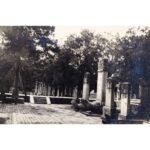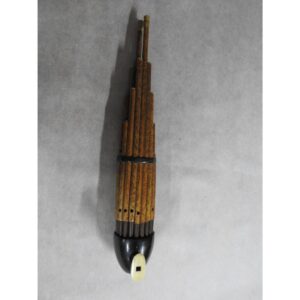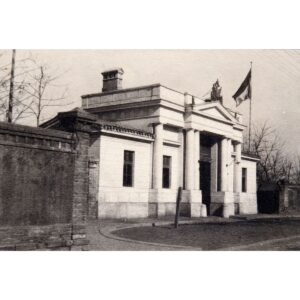Photography Hall of Classics at the Beijing Imperial Academy Guozijian
A black-and-white photograph showing the Hall of Classics (Biyong 辟雍) at the Guozijian Imperial Academy 北京國子監 in Beijing, a stone’s throw from the Temple of Confucius. The Hall of Classics was built in the 49th year of the reign of Emperor Qianlong (reigned 1735–1796) of the Qing Dynasty (1644–1911). Since then, it has been the central building of the Imperial Academy. The square-shaped temple with massive columns and eaves stands in the centre of a high square platform surrounded by a circular pond. The eaves with the railing form a covered porch around the entire building. On each side of the building there are gates to which four rectilinear bridges lead, with access via six steps to a platform. The name of the building is inscribed above the door in Chinese on the left and in Manchu on the right.
The hall was built using the traditional Chinese construction technique, the dougong 斗拱 system. In addition to dowels in the eaves, other features of Chinese ... more
A black-and-white photograph showing the Hall of Classics (Biyong 辟雍) at the Guozijian Imperial Academy 北京國子監 in Beijing, a stone’s throw from the Temple of Confucius. The Hall of Classics was built in the 49th year of the reign of Emperor Qianlong (reigned 1735–1796) of the Qing Dynasty (1644–1911). Since then, it has been the central building of the Imperial Academy. The square-shaped temple with massive columns and eaves stands in the centre of a high square platform surrounded by a circular pond. The eaves with the railing form a covered porch around the entire building. On each side of the building there are gates to which four rectilinear bridges lead, with access via six steps to a platform. The name of the building is inscribed above the door in Chinese on the left and in Manchu on the right.
The hall was built using the traditional Chinese construction technique, the dougong 斗拱 system. In addition to dowels in the eaves, other features of Chinese construction include roof shapes, the use of colours and numbers, and decorative animal figures. Shown here is a quatrefoil, wudianding 廡殿頂, with a layer of dowels under the eaves. Under the dowels there are usually walls decorated with blue, yellow and green patterns symbolising the sky god, the emperor and the common people. The lower eaves are supported by beams that form a porch around the entire building. The eaves are lined with nine glazed figures in strict order, beginning with the phoenix rider (ji feng xianren 騎鳳仙人), literally “daoist immortal riding the phoenix”. They are accompanied by two dragons, one on each side of the ridge. Together they are supposed to protect the building from natural disasters and malicious acts. The characteristic ground plan of a square (dwelling with building) in a circle (pond) symbolises harmonious creation – the balance between the earth (square) and the sky (circle). The motif is widespread in Chinese culture and can be found not only in architecture, but also in the shapes of coins, chariots, and carriages. The Guozijian Imperial Academy in Beijing was founded in 1306. It was the highest educational institution in the Yuan, Ming, and Qing Dynasties.
The photograph is the 205th of 449 photographs of Beijing and its surroundings in the album of Ivan Skušek Jr., purchased during his stay in Beijing (1914–1920). In the handwritten inventory of the album, the photograph is referred to as Klassiker-Halle: Tempel. (DZ, MV)





































Do you have a comment or additional information about the subject?